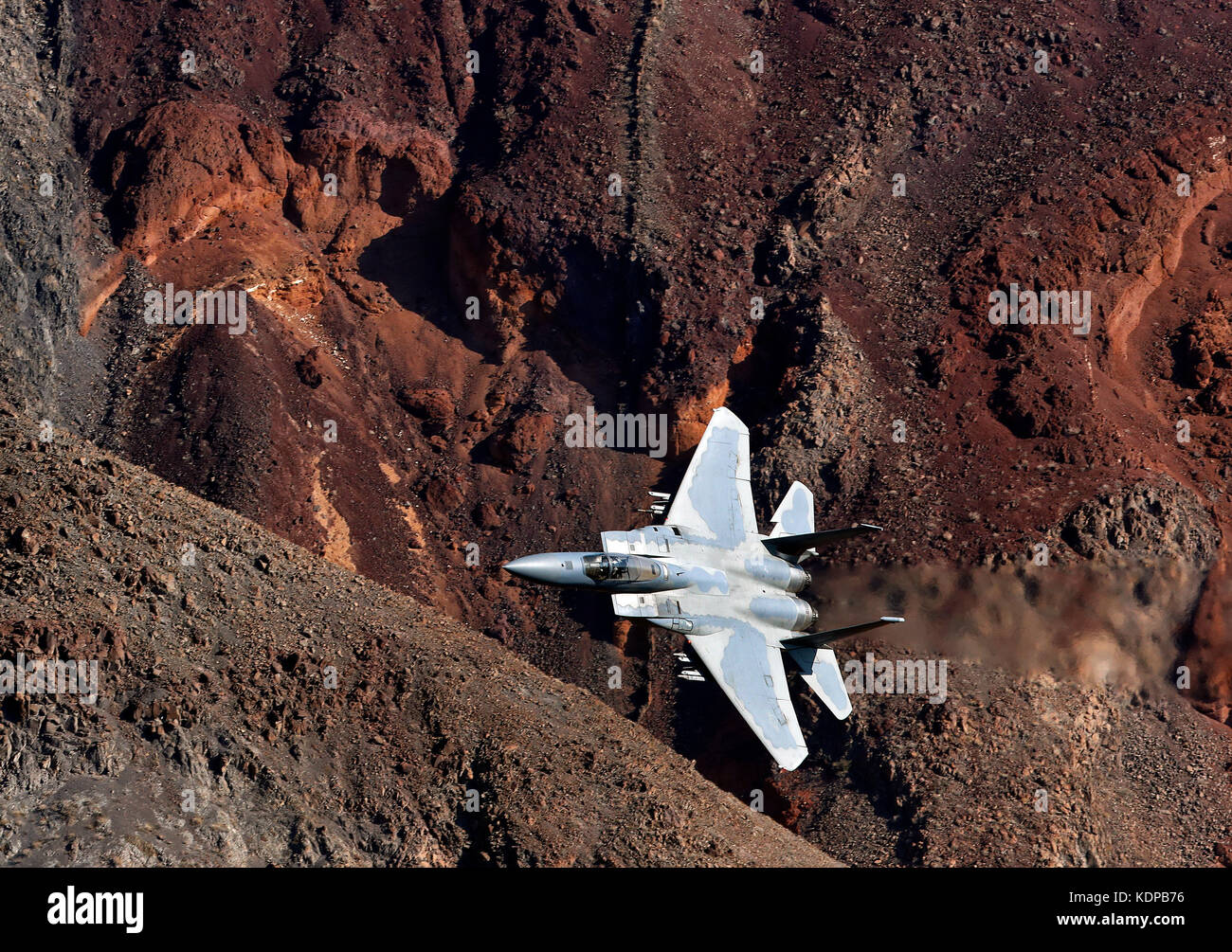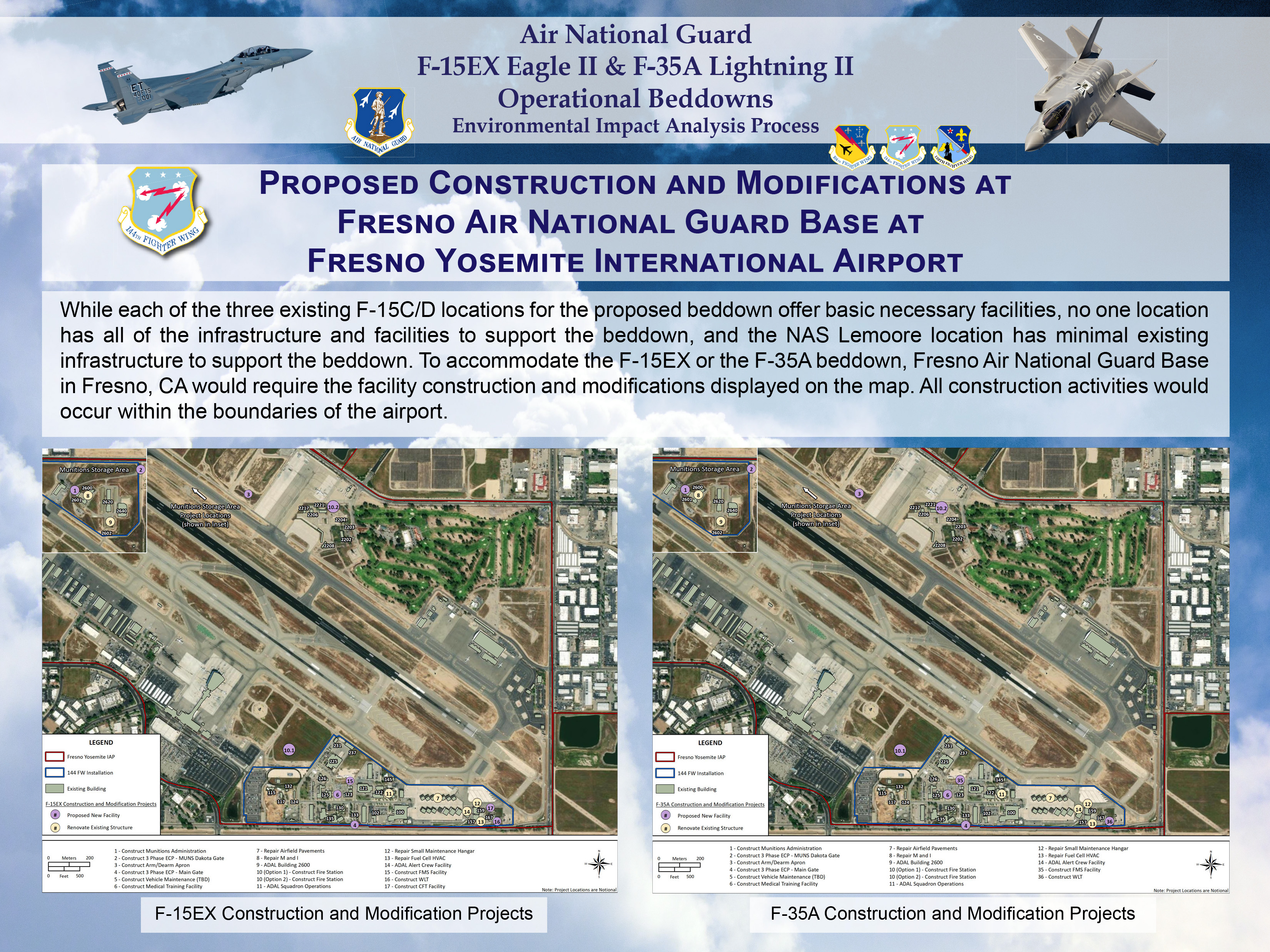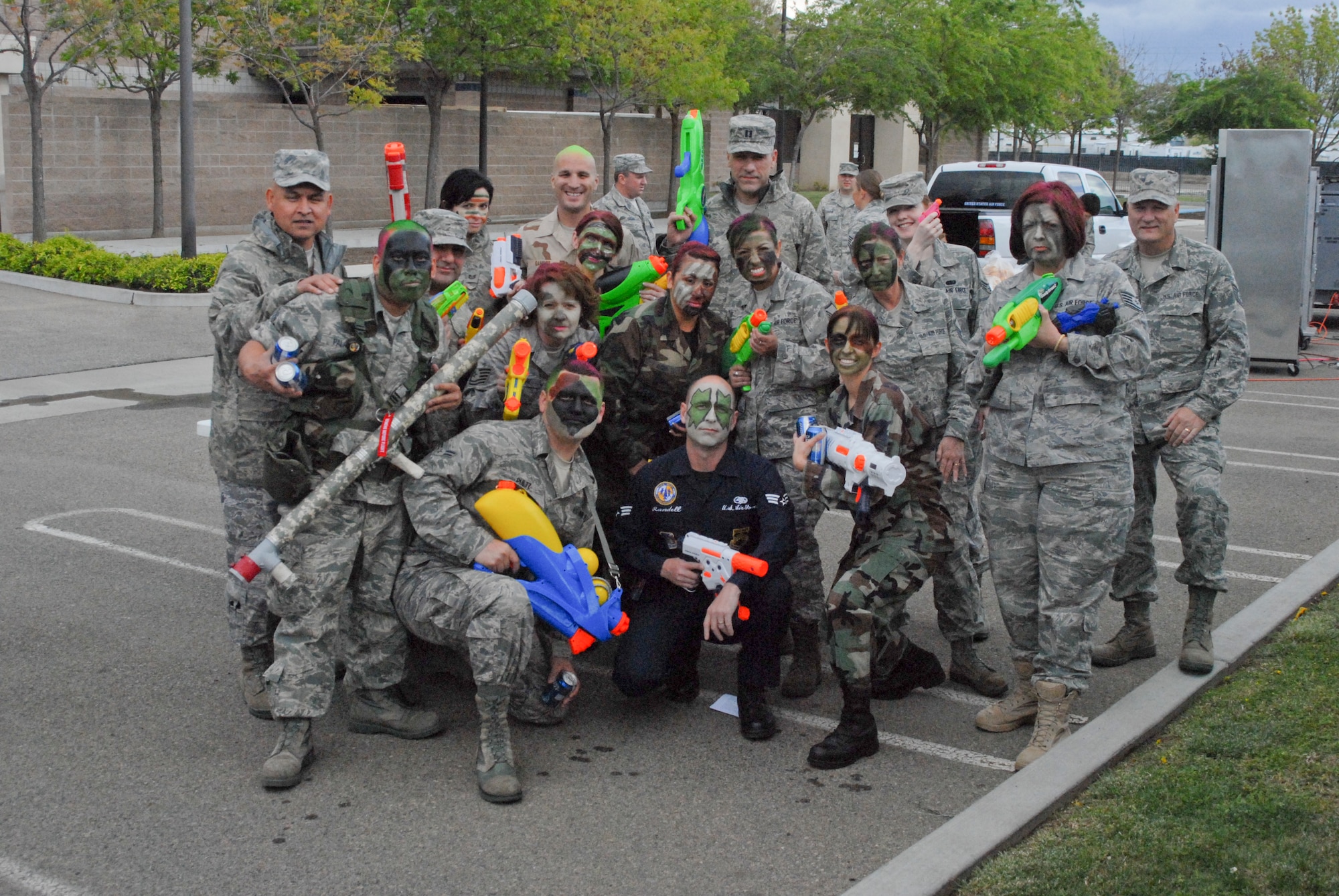Fresno Air National Guard - The 144th Fighter Wing (144 FW) is a unit of the California Air National Guard based at Fresno Air National Guard Base, California. As a component of the Air Reserves of the United States Air Force, this unit is managed by the Air Combat Command.
The 144th Wing's primary mission under USC Title 10 is to provide air defense protection for California and the United States from the Mexican border to Oregon using F-15 Eagle jet fighters. In its state mission under 32 USC, the 144th also supports the National Drug Enforcement Program and responds to state emergencies as requested by the Governor of California.
Fresno Air National Guard

The wing previously flew the F-16C and F-16D Fighting Falcon, with the last F-16C delivered to the Arizona Air Guard in November 2013. The aircraft inventory includes 21 F-15C and F-15D. 18 Primary Licensed Aircraft (PAA) and 3 Reserve Aircraft Invtory (BAI) previously assigned to Montana Air National Guard, Missouri Air National Guard and Nellis Air Force Base. The wing also operates a C-26A transport.
U.s. Air Force Col. Drake Reed, 144th Fighter Wing Commander, Speaks To Wing Members And Merced City Leaders During A Cities Of Honor Ceremony At The Fresno Air National Guard Base, California,
Activated in Oct 1943 as the 372nd Fighter Group at Hamilton Field, California. During World War II, the squadron was an Operational Training Unit (OTU) equipped with second generation P-39 Airacobras and P-40 Warhawks. Your job is to train the newly graduated pilots of the Training Command in tactics and combat skills before they are assigned to your permanent fighter team. Originally assigned to IV Fighter Command, it was transferred to III Fighter Command in 1944, re-equipped with P-51D Mustangs. It participated in ground maneuvers and demonstrations, in the Louisiana maneuvers in the summer of 1944, and in similar operations in the US until V-J Day.
The 372nd Fighter Group was reactivated and designated as the 144th Fighter Group and assigned to the California Air National Guard on 24 May 1946. It was stationed at Alameda Naval Air Station, California, and extended government recognition. June 2, 1948 by the National Guard Bureau. The 144th Fighter Group will be given the family, history, honor and colors of the 372nd and all previous units. The group was assigned to the 61st Fighter Wing of the California ANG.
These three members were all part of the 372nd operational units during World War II. All are initially equipped with F-51D Mustang missiles, which have the mission of air defense of their host nation.
In 1949, the 144th and designated 194th Fighter Squadron moved from NAS Alameda to the former Hayward Army Airfield designated as an Air National Guard Base. In October 1950, the Air National Guard became a base organization (Hobson's Plan). As a result, the 61st Fighter Wing was removed from ANG California and inactivated on 31 October 1950. employee , equipment and mission of the 61st Passive Fighter Wing. The 144th fighter group was assigned to the new wing as its operational group with three combat squadrons.
California Air National Guard
With the surprise attack on South Korea on May 25, 1950 and the unpreparedness of the Air Force due to postwar manpower reductions and the heavy emphasis on the nuclear strike mission of the Strategic Air Forces in the active Air Force, much of the Air National Guard is government and government. placed on active duty. Members of the 144th Fighter Group were retained by the Air National Guard and not deployed, but many pilots from all three members of the group volunteered for combat duty. The F-51Ds were replaced by F-51H Mustangs in 1951 because the "D" model of the Mustang was needed for close air missions in Korea. The F-51H is a long-range version of the Mustang that was developed to carry B-29 Superfortress fighters to Japan, but was not robust enough for use in Korea. However, the increased size is suitable for air raid warning aircraft. During its years with the P-51H, the unit was known as one of the Air Force's most respected aerial gunners. In May 1953, during the Mustang flight, the unit qualified for the first international gunners' meeting. Using leased F-86A Saber aircraft, the 144th, which
194th Fighter-Interceptor Squadron McDonnell F-4D-26-MC Phantom II, AF Ser. #65-0588, now on static display at Fresno Air National Guard Base.
With increased aircraft availability after the Korean War, the squadron's piston-engined, propeller-driven F-51H was upgraded to its first combat aircraft, the F-86A Saber Day Interceptor, in 1954. At the same time, the 194th was transferred to the Fresno Air Terminal, and in 1957 the 144th Wing was redesignated the 194th Fighter-Interceptor Wing, a designation the wing would retain for the next 37 years. With the F-86A, the 144th began night-to-dawn alerts, joining active-duty Air Defense Command (ADC) partners, and the 144th served as the ADC for the active-duty US Air Force under 10 USC.

The 194th continued to fly the F-86A until March 31, 1958. On April 1, 1958, it was converted to the F-86L Saber Interceptor, originally designed as an interceptor with all-weather capability. all weather. In addition, the F-86L can be controlled and guided by SAGE Ground Control Systems (radar) computers, which maneuver the aircraft to an unknown target for interception.
Th Fighter Wing Welcomes F 117 Nighthawks For Training > 144th Fighter Wing > Article Display
In 1958, the Air National Guard of Nevada and Utah was authorized to expand to the division level. 152nd Fighter-Interceptor Group, Nevada ANG, officially designated 19 Apr 1958; 151st Fighter-Interceptor Group, Utah ANG, 1 July 1958. With the formation of the organizational structure and management of Nevada and Utah, command and control of the 191st and 192nd FIS was transferred to their respective state organizations.
On July 1, 1964, the 194th began flying the F-102A Delta Dagger, a high-speed Mach 1.25 fighter. In January 1968, the Air Defense Command became the Defense Aerospace Command and continued operational responsibility. On July 25, 1974, the 194th retired the F-102 and entered service with the upgraded F-106 Delta Dart, continuing to fly the aircraft until February 31, 1983. On October 1, 1978, the Anti-Space Command was activated, and its divisions are also divided into divisions. The weather. Defense, Air Tactical Command (ADTAC), a sub-element of Tactical Air Command (TAC), with ADTAC established as an Air Force attachment under TAC. TAC later replaced the aging F-106 on 1 January 1984 with the F-4D Phantom II for use in the air defense mission. On December 6, 1985, ADTAC was created and its roles and responsibilities assumed by the reconstituted Air Force Command, the TAC organization that provides operational control for all Air Force combat components.
These are among 15 types that will replace the F-4D in air defense and attack roles. Block 15 aircraft are not fully suited to the mission of the coalition air force. This was rectified when the aircraft received an anti-aircraft defense (ADF) upgrade in 1990.
Effective 16 March 1992, the 144th Fighter Wing was redesignated the 144th Fighter Wing (144 FW), with all associated groups and squadrons becoming fighter groups and fighter squadrons. On 1 June 1992, following the disbandment of the Tactical Air Command (TAC), the 144th FW was assigned to the newly formed Air Combat Command (ACC) under First Air Force.
Th Fighter Wing Welcomes F 117 Nighthawks For Training > Air National Guard > Article Display
194th Fighter Wing General Dynamics F-16C Block 25E Fighting Falcon, AF Ser. #84-1376, flew over the Sierra Nevada in 2002 with four AIM-120 missiles.
At this time the 194th Fighter Squadron also had a warning group at George AFB in Victorville, California. George AFB was closed in 1992 due to Operation BRAC as part of the overall post-Cold War downsizing of the US military, and the alert detachment moved to March Air Force Base as BRAC was relocated as March Air Force Reserve Base due to subsequent operations. In 1995, the squadron switched to the more powerful F-16C Fighting Falcon Block 25.
The 144th Fighter Wing was the nation's busiest air defense wing in 1999, deployed to eight countries and more than half a dozen states. Combat training has many highlights throughout the year. 50 members sent five F-16s to Naval Air Station Fallon, Nevada, to participate in the annual Nevada Joint Strike Fighter exercise. Team members also travel to Tyndall AFB, Florida for Combat Archery, which provides firearms training opportunities. To start the year, six dozen members and six aircraft were deployed to Nellis AFB, Nevada from October 24 to November 7 to receive the Red Flag. In the opening minutes of the exercise, four aircraft of the 144th Fighter Wing - a kill of four aircraft of the 144th Fighter Wing - killed four real MiG-29s. These were the first MiG-29 kills in Red Flag exercises.
Also in 1999, the firing of the 144th civil engineering
California Guard Ordered Fighter Jet Ready For Civil Unrest
National guard fresno ca, guard card fresno, air national guard fresno ca, air national guard fresno, fresno air national guard base, fresno air guard, fresno national guard, army national guard fresno, fresno security guard, california air national guard fresno, security guard fresno ca, fresno national guard armory

0 Comments